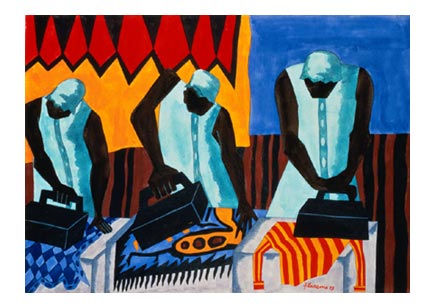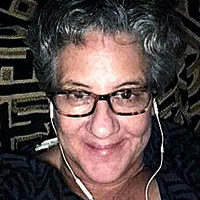
NEW YORK (AP) – For a tribute in verse to one of the 20th century’s greatest painters, the late Jacob Lawrence, only the finest poets would do.
Pulitzer Prize winner Yusef Komunyakaa, former poets laureate and Pulitzer winners Rita Dove and Natasha Trethewey and National Book Award winners Terrance Hayes and Nikky Finney were among 10 special guests Friday night at the Museum of Modern Art. They read original works inspired by Lawrence’s celebrated “The Migration Series,” commissioned for a Lawrence exhibition at MOMA that runs until Sept. 7.
“Art begets art and influence crosses art forms,” explained the evening’s host, Elizabeth Alexander, herself an acclaimed poet who in 2009 read at President Obama’s first inaugural.
“Prepare to be dazzled,” she added as she brought the poets to the stage, including Tyehimba Jess, Patricia Spears Jones, Lyrae Van Clief-Stefanon, Crystal Williams, and Kevin Young.
“The Migration Series” is a sequence of 60 panels, completed in 1941, that narrate and personalize the mass journey of blacks from the rural South to the urban North between World War I and World War II. Lawrence was in his early 20s at the time, but with remarkable sophistication captured a generation’s struggles and hopes through silhouetted figures, sharp outlines and a narrow, but striking range of colors.
The paintings predate the civil rights era by more than a decade, but the poets sadly pointed out their relevance to today, with some making references to the police shooting of Michael Brown in Ferguson, Missouri, and the death of Freddie Gray while in the custody of police in Baltimore. Among the panels singled out by poets was No. 21, showing three blacks in jail, handcuffed together, heads bent. No. 14 pictures a white judge facing down two blacks in court, while No. 15 features a tree branch with a rope hanging from it.
Jess’ “Another Man Done” was a stuttering, rapping rundown of blacks and the law:
They were arrested at the slightest provocation.
They were arrested at the slightest provocation.
They were at the slightest provocation.
They were the slightest provocation.
They were provocation.
They were
They were
They were.
Each reader had his or her own story to tell of family members moving about the country, with the Ohio-born Dove remembering the drawls of her Georgian elders, and of how they came to write their Lawrence poems. Finney said she placed Xeroxed copies of Lawrence’s paintings on her kitchen wall, in numerical order, and was inspired to write a poem in which each stanza included 60 words and ended with the word “sixty.” Hayes was taken by No. 9, a portrait of boll weevils eating into crops, and imagined “a brood of boll weevils migrating to the U.S./In bales of Mexican cotton.” Jones based her poem “Lava” on No. 57, in which a lone washer woman lowers a rod into a swarm of clothing.
She stands in this painting
A cruciform of desire
In a center of beauty
Dressed in white, the orange stick
Her cudgel, her sword. The laundry
Her step on that ladder to the future.
Photo: A painting by Lawrence, in a style known as “dynamic cubism.” | assatashakur.org










